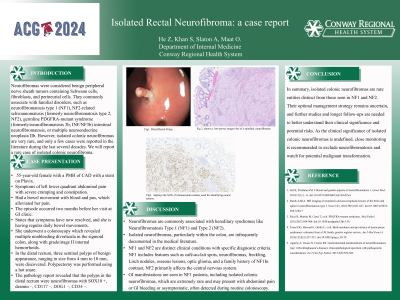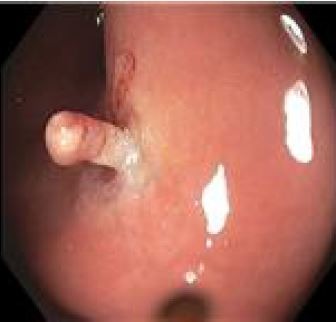Tuesday Poster Session
Category: Colon
P3797 - Isolated Rectal Neurofibroma: A Case Report
Tuesday, October 29, 2024
10:30 AM - 4:00 PM ET
Location: Exhibit Hall E

Has Audio

Zhexiang He, DO
Conway Regional Health System
Conway, AR
Presenting Author(s)
Zhexiang He, DO, Shuja Khan, MD, Arthur Slaton, MD, Owen Maat, MD
Conway Regional Health System, Conway, AR
Introduction: Neurofibromas are considered benign peripheral nerve sheath tumors containing Schwann cells, fibroblasts, and perineurial cells. They are commonly associated with familial disorders, such as neurofibromatosis type 1, NF2-related schwannomatosis, germline PDGFRA-mutant syndrome, etc. However, isolated colonic neurofibromas are very rare, and only a few cases were reported in the literature during the last several decades. In this report, we present a rare case of isolated colonic neurofibroma.
Case Description/Methods: The patient is a 55-year-old female with a medical history of coronary artery disease (CAD) with a stent on Plavix. She was referred to the gastroenterology clinic due to abdominal pain associated with bleeding that had been occurring for a week. The patient described experiencing left lower quadrant abdominal pain with severe cramping and constipation. During this period, she had a bowel movement with blood and pus, which alleviated her pain. The episode occurred two months before her visit to the clinic. She mentioned that her symptoms have now resolved, and she is having regular daily bowel movements.
She underwent colonoscopy which revealed multiple nonbleeding diverticula which were found in the sigmoid colon, along with grade/stage II internal hemorrhoids. In the distal rectum, three sentinel polyps of benign appearance, ranging in size from 4 mm to 10 mm, were discovered. They were removed through a single piece polypectomy using a hot snare. The pathology report revealed that the polyps in the distal rectum were neurofibromas with SOX10 +, desmin –, CD117 –, DOG1 –, CD34 –.
The patient was contacted and scheduled for a follow-up colonoscopy in 6 months.
Discussion: Neurofibromas represent benign tumors emerging from peripheral nerve sheath components, comprising Schwann cells, fibroblasts, and perineurial cells. While multiple neurofibromas are commonly associated with hereditary syndrome, isolated neurofibromas exist but are not well-described.
While NF1-associated neurofibromas harbor the risk of malignant transformation into malignant peripheral nerve sheath tumors (MPNSTs), the malignancy potential for isolated colonic neurofibromas remains uncertain due to the lack of data.
The clinical significance of isolated colonic neurofibromas is yet to be established due to its rarity; the optimal management strategy remains uncertain. Close monitoring is advocated to both exclude the possibility of neurofibromatosis and be vigilant about the risk of malignant transformation.

Note: The table for this abstract can be viewed in the ePoster Gallery section of the ACG 2024 ePoster Site or in The American Journal of Gastroenterology's abstract supplement issue, both of which will be available starting October 27, 2024.
Disclosures:
Zhexiang He, DO, Shuja Khan, MD, Arthur Slaton, MD, Owen Maat, MD. P3797 - Isolated Rectal Neurofibroma: A Case Report, ACG 2024 Annual Scientific Meeting Abstracts. Philadelphia, PA: American College of Gastroenterology.
Conway Regional Health System, Conway, AR
Introduction: Neurofibromas are considered benign peripheral nerve sheath tumors containing Schwann cells, fibroblasts, and perineurial cells. They are commonly associated with familial disorders, such as neurofibromatosis type 1, NF2-related schwannomatosis, germline PDGFRA-mutant syndrome, etc. However, isolated colonic neurofibromas are very rare, and only a few cases were reported in the literature during the last several decades. In this report, we present a rare case of isolated colonic neurofibroma.
Case Description/Methods: The patient is a 55-year-old female with a medical history of coronary artery disease (CAD) with a stent on Plavix. She was referred to the gastroenterology clinic due to abdominal pain associated with bleeding that had been occurring for a week. The patient described experiencing left lower quadrant abdominal pain with severe cramping and constipation. During this period, she had a bowel movement with blood and pus, which alleviated her pain. The episode occurred two months before her visit to the clinic. She mentioned that her symptoms have now resolved, and she is having regular daily bowel movements.
She underwent colonoscopy which revealed multiple nonbleeding diverticula which were found in the sigmoid colon, along with grade/stage II internal hemorrhoids. In the distal rectum, three sentinel polyps of benign appearance, ranging in size from 4 mm to 10 mm, were discovered. They were removed through a single piece polypectomy using a hot snare. The pathology report revealed that the polyps in the distal rectum were neurofibromas with SOX10 +, desmin –, CD117 –, DOG1 –, CD34 –.
The patient was contacted and scheduled for a follow-up colonoscopy in 6 months.
Discussion: Neurofibromas represent benign tumors emerging from peripheral nerve sheath components, comprising Schwann cells, fibroblasts, and perineurial cells. While multiple neurofibromas are commonly associated with hereditary syndrome, isolated neurofibromas exist but are not well-described.
While NF1-associated neurofibromas harbor the risk of malignant transformation into malignant peripheral nerve sheath tumors (MPNSTs), the malignancy potential for isolated colonic neurofibromas remains uncertain due to the lack of data.
The clinical significance of isolated colonic neurofibromas is yet to be established due to its rarity; the optimal management strategy remains uncertain. Close monitoring is advocated to both exclude the possibility of neurofibromatosis and be vigilant about the risk of malignant transformation.

Figure: Distal Rectal Polyp
Note: The table for this abstract can be viewed in the ePoster Gallery section of the ACG 2024 ePoster Site or in The American Journal of Gastroenterology's abstract supplement issue, both of which will be available starting October 27, 2024.
Disclosures:
Zhexiang He indicated no relevant financial relationships.
Shuja Khan indicated no relevant financial relationships.
Arthur Slaton indicated no relevant financial relationships.
Owen Maat indicated no relevant financial relationships.
Zhexiang He, DO, Shuja Khan, MD, Arthur Slaton, MD, Owen Maat, MD. P3797 - Isolated Rectal Neurofibroma: A Case Report, ACG 2024 Annual Scientific Meeting Abstracts. Philadelphia, PA: American College of Gastroenterology.

